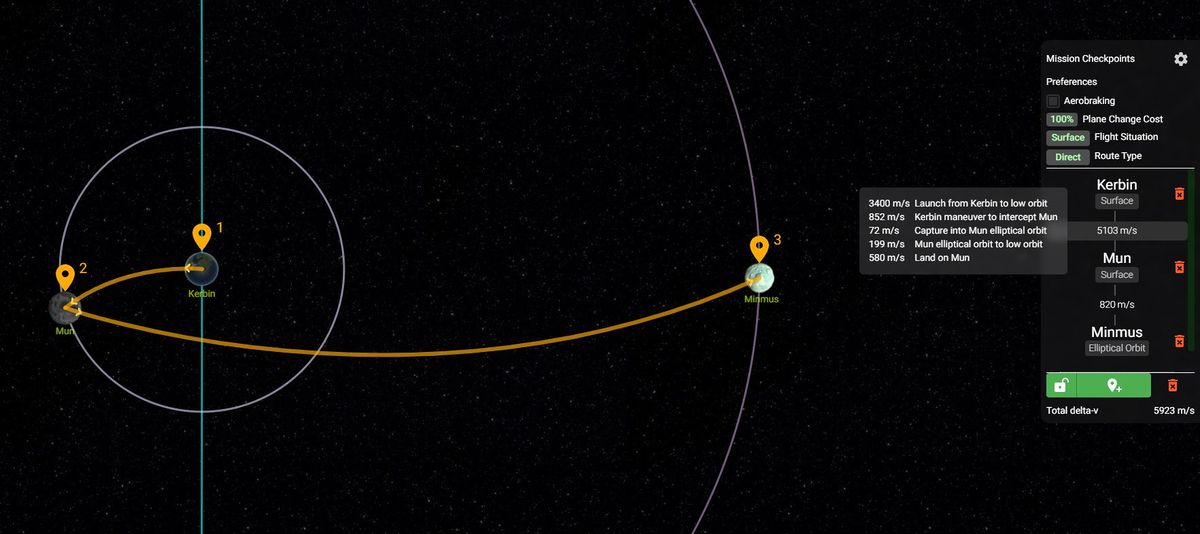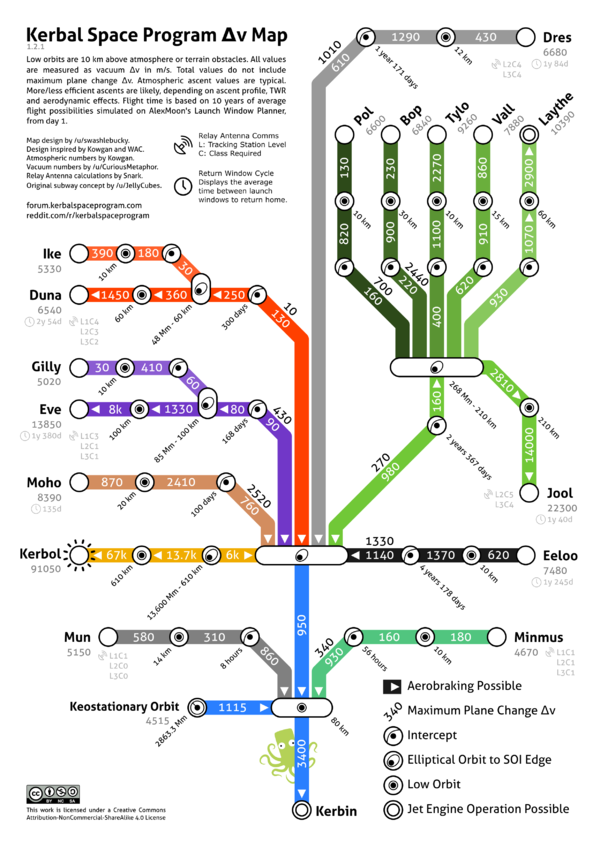Kerbal Space Delta V Map How to Read
| | This page or section is in need of beingness brought up to engagement. Please assistance Kerbal Infinite Program Wiki past fixing inaccurate or outdated data.
|
Kerbal Space Program rocket scientist's cheat sheet: Delta-5 maps, equations and more than for your reference so you can become from here to at that place and back again.
Contents
- 1 Mathematics
- 1.1 Thrust-to-weight ratio (TWR)
- one.2 Specific Impulse (Isp)
- 1.3 Delta-five (Δv)
- i.iii.one Basic adding
- 1.3.ii True Δv of a stage that crosses from atmosphere to vacuum
- 1.3.3 Maps
- 1.3.4 Maximum Δv nautical chart
- 2 Math examples
- two.1 TWR
- 2.ii Isp
- 2.3 Δv
- 2.4 Maximum Δv
- ii.5 Truthful Δv
- 3 Run into besides
Mathematics
Thrust-to-weight ratio (TWR)
- → Meet also: Thrust-to-weight ratio
How hard exercise your engines button UP? That's "thrust".
How difficult does gravity pull Downward? That's "weight".
The ratio of those two is, surprisingly, the "thrust-to-weight" ratio.
If thrust is pushing harder than weight, your rocket goes up! Hooray!
If weight is pulling harder than thrust, your rocket does not go up. Sad!
That's the "thrust-to-weight" ratio, or TWR, in a nutshell.
If TWR is less than one, and then your rocket will non exist going into space. You will need more engines, or maybe MOAR BOOSTERZ!
If TWR is significantly to a higher place, say, 2.0, your rocket will ZOOM! Simply it might ZOOM likewise hard for your poor Kerbalnauts. Most rockets, direct off the launch pad, will use a TWR between 1.5 and ii.0.
Specific Impulse (Isp)
- → Run across too: Specific impulse
Specific impulse measures the efficiency of a detail engine. Because this depends on the force per unit area of a rocket's surroundings, this can change between Body of water Level and Vacuum (in space). Almost engines are designed for optimal operation either at Sea Level (the big ones that drive your first stage and boosters, which take lots of thrust!) or Vacuum (where they won't burn down equally much propellant, but tin be VERY efficient).
Specific impulse is used in of import equations like THE ROCKET EQUATION (see next department) to determine how much oomph (or "delta-vee") you can get out of a given amount of propellant. The college the specific impulse, the more than efficient an engine is!
In real life, specific impulse is governed past things similar combustion chamber force per unit area and propellant free energy (hydrogen/oxygen is more efficient than kerosene/oxgyen). Fortunately for Jebediah, our honey Kerbals only accept one make of fuel to worry nigh.
Delta-v (Δv)
Bones calculation
- → Come across also: Tutorial:Advanced Rocket Blueprint
Basic calculation of a rocket'due south Δv. Use the atmospheric and vacuum thrust values for atmospheric and vacuum Δv, respectively.
True Δv of a stage that crosses from temper to vacuum
| Torso | Δvout |
|---|---|
| Kerbin | 2500 m/south |
| other bodies' data missing | |
Calculation of a rocket stage'due south Δv, taking into account transitioning from atmosphere to vacuum. Δvout is the amount of Δv required to leave a body'southward atmosphere, non attain orbit. This equation is useful to figure out the bodily Δv of a stage that transitions from temper to vacuum.
Maps
Various fan-fabricated maps showing the Δv required to travel to a certain body.
KSP Visual Calculator, online tool that determines delta-five required for multiple checkpoint missions
- https://ksp-visual-figurer.blaarkies.com

Subway mode Δv map (KSP i.ii.one):

Total Δv values
- http://www.skyrender.net/lp/ksp/system_map.png
Δv change values
- http://i.imgur.com/duY2S.png
Δv with Phase Angles
- http://i.imgur.com/dXT6r7s.png
Precise Total Δv values
- http://i.imgur.com/UUU8yCk.png
WAC'southward Δv Map for KSP 1.0.4
- http://i.imgur.com/q0gC9H7.png
Maximum Δv chart
- This nautical chart is a quick guide to what engine to utilise for a unmarried stage interplanetary send. No affair how much fuel yous add you volition never reach these ΔV without staging to shed mass or using the slingshot maneuver. (These calculations use a full/empty fuel-tank mass ratio of 9 for all engines except those noted.)
-
Isp(Vac) (s) Max Δv (m/south) Engines Remarks 250 5249 O-ten "Puff" Monopropellant (max total/empty mass ratio = viii.five) 290 6249 LV-1R "Spider"
24-77 "Twitch"300 6464 KR-1x2 "Twin-Boar" 305 6572 CR-seven R.A.P.I.Eastward.R.
Mk-55 "Thud"310 6680 LV-T30 "Reliant"
RE-M3 "Mainsail"315 6787 LV-1 "Ant"
KS-25 "Vector"
KS-25x4 "Mammoth"320 6895 48-7S "Spark"
LV-T45 "Swivel"
RE-I5 "Skipper"340 7326 KR-2L+ "Rhino"
T-1 "Dart"345 7434 LV-909 "Terrier" 350 7542 RE-L10 "Poodle" 800 17238 LV-North "Nerv" 4200 58783 Ix-6315 "Dawn" Xenon (max full/empty mass ratio = 4.167)
(Version: 1.6.i)
Math examples
TWR
- Copy template:
-
- TWR = F / (one thousand * g) > 1
Isp
- When Isp is the aforementioned for all engines in a stage, then the Isp is equal to a single engine. And then half dozen 200 Isp engines yet yields simply 200 Isp.
- When Isp is different for engines in a single stage, and then utilise the following equation:
- Equation:
- Simplified:
-
- Isp = ( F1 + F2 + ... ) / ( ( F1 / Isp1 ) + ( F2 / Isp2 ) + ... )
- Explained:
-
- Isp = ( Force of thrust of 1st engine + Force of thrust of 2d engine...and then on... ) / ( ( Force of thrust of 1st engine / Isp of 1st engine ) + ( Force of thrust of 2nd engine / Isp of 2nd engine ) + ...and so on... )
- Case:
- Two engines, one rated 200 newtons and 120 seconds Isp ; another engine rated 50 newtons and 200 seconds Isp.
- Isp = (200 newtons + 50 newtons) / ( ( 200 newtons / 120 ) + ( 50 newtons / 200 ) = 130.4347826 seconds Isp
Δv
- For atmospheric Δv value, use atmospheric values.
- For vacuum Δv value, use vacuum values.
- Use this equation to figure out the Δv per stage:
- Equation:
- Simplified:
-
- Δv = ln ( Mstart / Mdry ) * Isp * chiliad
- Explained:
-
- Δv = ln ( starting mass / dry mass ) Ten Internet access provider X 9.81
- Instance:
- Single phase rocket that weighs 23 tons when full, 15 tons when fuel is emptied, and engine that outputs 120 seconds Isp.
- Δv = ln ( 23 Tons / 15 Tons ) × 120 seconds Isp × nine.81m/s² = Total Δv of 503.0152618 m/s
Maximum Δv
- Simplified version of the Δv calculation to find the maximum Δv a arts and crafts with the given ISP could hope to reach. This is done by using a magic 0 mass engine and not having a payload.
- Equation:
- Simplified:
-
- Δv =21.576745349086 * Isp
- Explained / Examples:
- This calculation only uses the mass of the fuel tanks and and then the ln ( Mstart / Mdry ) office of the Δv equation has been replaced by a constant as Mstart / Mdry is ever ix (or worse with some fuel tanks) regardless of how many fuel tanks you utilise.
- The following example will use a single stage and fuel tanks in the T-100 to Jumbo 64 range with an engine that outputs 380 seconds Isp.
- Δv = ln ( 18 Tons / 2 Tons ) × 380 seconds Isp × ix.81m/s² = Maximum Δv of 8199.1632327878 m/s
- Δv = 2.1972245773 × 380 seconds Isp × ix.82m/s² = Maximum Δv of 8199.1632327878 m/southward (Replaced the log of mass with a abiding every bit the ratio of total mass to dry out mass is constant regardless of the number of tanks used every bit there is no other mass involved)
- Δv = 21.576745349086 × 380 seconds Isp = Maximum Δv of 8199.1632327878 one thousand/s (Reduced to its well-nigh simple class by combining all the constants)
Truthful Δv
- How to summate the Δv of a rocket stage that transitions from Kerbin atmosphere to vacuum.
- Assumption: Information technology takes roughly 2500 thousand/south of Δv to escape Kerbin'southward atmosphere before vacuum Δv values take over for the stage powering the transition (actual value ranges between 2000 thousand/s and 3400 m/s depending on ascent). Note that, as of KSP 1.iii.1, effectually 3800 1000/s of Δv is required to reach an 80km orbit from the KSC.
- Note: This equation is a guess, an approximation, and is not 100% accurate. Per forum user stupid_chris who came up with the equation: "The results will vary a bit depending on your TWR and such, but it should usually be pretty darn authentic."
- Equation for Kerbin atmospheric escape:
- Simplified:
-
- Truthful Δv = ( ( Δv atm - 2500 ) / Δv atm ) * Δv vac + 2500
- Explained:
-
- True Δv = ( ( Total Δv in atmosphere - 2500 1000/s) / Total Δv in temper ) X Total Δv in vacuum + 2500
- Example:
- Single phase with total atmospheric Δv of 5000 one thousand/due south, and rated 6000 Δv in vacuum.
- Transitional Δv = ( ( 5000 Δv atm - 2500 Δv required to escape Kerbin atmosphere ) / 5000 Δv atm ) X 6000 Δv vac + 2500 Δv required to escape Kerbin atmosphere = Total Δv of 5500 m/s
See also
- Tutorials
- Terminology
- The Drawing Lath: A library of tutorials and other useful information
bergspectlemeded1971.blogspot.com
Source: https://wiki.kerbalspaceprogram.com/wiki/Cheat_sheet







0 Response to "Kerbal Space Delta V Map How to Read"
Post a Comment